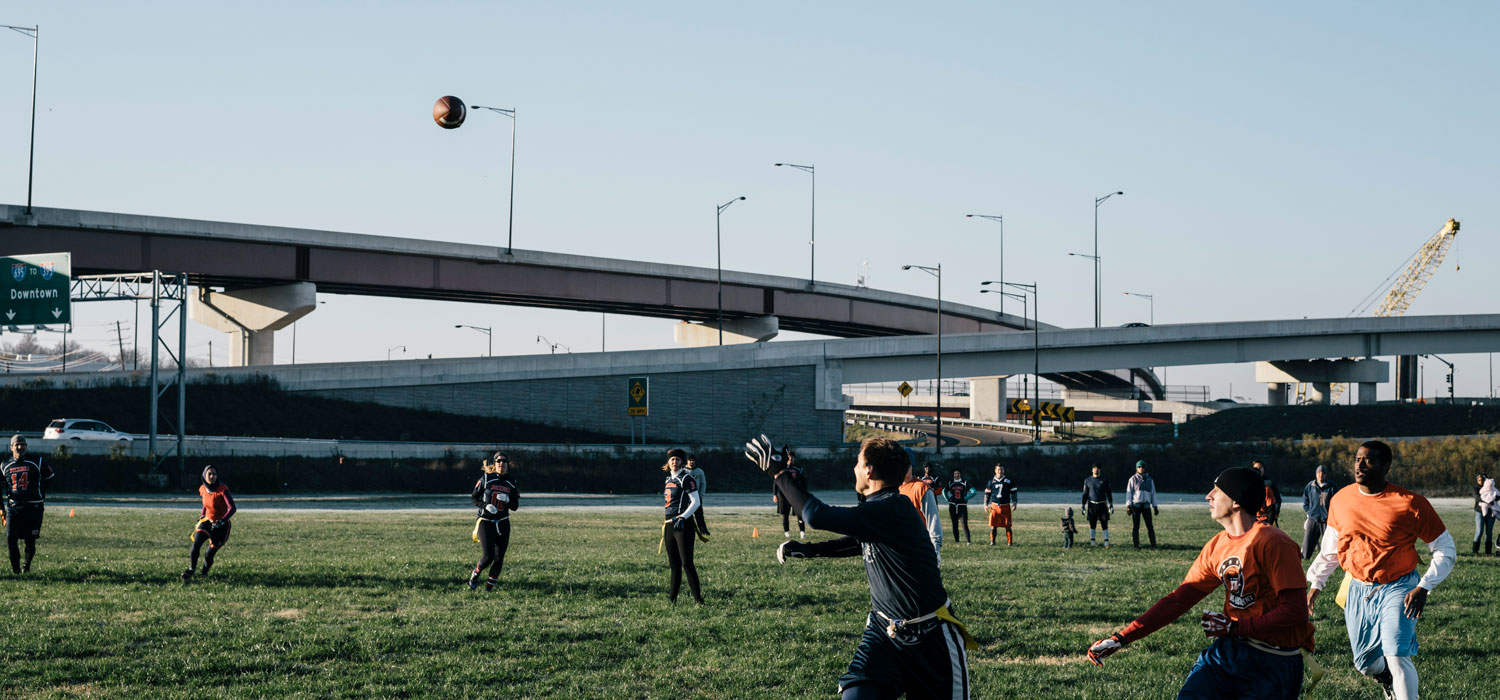
<p>Players take the field on the Capitol Alumni Network flag football league at Anacostia Park near the 11th Street Bridge on Dec. 05, 2015. Photo by Greg Kahn/GRAIN for The Washington Post via Getty Images.</p>
Washington, DC, continues to grow and develop, with more people moving into the city and being born here every day. The latest population estimates peg DC’s population at more than 693,000, the largest number since the end of World War II.
As the city grows, development pressures will continue to mount. When development reaches its limits in certain neighborhoods, people will look for opportunities elsewhere in the city. Development can bring new investment to such areas as communities east of the Anacostia River that have suffered from structural disinvestment, but it can also increase living costs and displace residents.
The 11th Street Bridge Park, a project of the Ward 8 nonprofit Building Bridges across the River, demonstrates the possibilities and challenges of development. The park and City First Enterprises are spearheading a new community land trust with financial backing from the JPMorgan Chase Foundation, Citi Foundation, and Ford Foundation. The land trust will focus on the Anacostia and Fairlawn communities, but it could include other areas.
The Urban Institute is helping track the community land trust’s progress to verify that it is accomplishing the bridge park’s goals to spur positive development while protecting current residents.
Protecting residents from displacement
The recent VoicesDMV survey found the threat of displacement is real for many in DC and in the broader region, primarily because of the rising cost of living. Too often, new development does not serve current residents because it excludes their concerns and disempowers their input. If community leaders don’t preserve and create affordable housing and economic opportunity in communities like Anacostia and Fairlawn, people who have lived there for generations could be pushed out.
We’ve seen this before. DC has a long history of neighborhood revitalization functioning as an engine of displacement, often driven by racist assumptions and a colonialist understanding of landownership.
In the 1930s, Southwest DC was one of the first areas to undergo “urban renewal,” an infamous clearing of street dwellings and low-income residents that later earned the nickname “Negro removal.” Language from the National Capital Park and Planning Commission’s 1930 annual report demonstrates the racial underpinnings of the revitalization (“The search for vacant houses is confined to negro blocks so as not to raise any questions as to the change in the population of a given square”) and its underestimation of the initiative’s impact (“The evidence indicates that there are [available dwellings], that there will be no real hardship to tenants”).
The 11th Street Bridge Park—cognizant of this history, its potential displacement risk, and the racial dynamics of a still deeply segregated city—is taking steps to address these issues. The bridge park has included affordable housing as one of the main elements of its equitable development plan, and the creation of a new community land trust is one of the key strategies.
The role of community land trusts
Community land trusts help preserve affordability and prevent displacement in communities undergoing rapid change. These private nonprofit corporations buy and hold land and then make that land available for residential or commercial development that aims to benefit the community.
Community members typically make up a majority of the board of directors to ensure development decisions serve community interests. The bridge park is following this model by including a two-thirds majority of local residents on the advisory committee making early decisions about the new land trust.
One of the main goals of the new community land trust will be to sell homes at affordable prices to low- and moderate-income residents, giving them a more stable foothold in the community.
The map below shows that areas east of the Anacostia River have many city-owned or vacant land parcels that could be acquired by the new community land trust.

Other tactics to shield neighborhoods from the negative effects of development
Community land trusts can offer permanent affordable housing, but they aren’t the only way to shield neighborhoods from the negative effects of development. The following measures can help protect the neighborhoods near the 11th Street Bridge Park:
Preserve existing affordable housing.
The bridge park’s impact area contains 10 percent of the city’s subsidized housing units. With more investment flowing into the area, maintaining that affordable housing will be critical. The DC Preservation Network, the DC Housing Preservation Strike Force, and other groups that identify and preserve at-risk affordable housing will be crucial to preserving the impact area.
Increase investment in affordable housing.
Between 2012 and 2016, 49 percent of DC-area renters paid more than 30 percent of their income on rent, a level considered unaffordable. Despite DC’s significant investment in its Housing Production Trust Fund, households struggle to afford housing. Increasing DC’s investment in affordable housing will protect residents from the potential displacing effects of increased development.
Use development to create well-paying jobs and small business opportunities for DC residents.
One of the best ways to ensure residents benefit from new development is to ensure they have access to the jobs and business opportunities that arise during and after construction. The bridge park has included these elements in its equitable development plan. The DC government and developers should work with unions to identify the sectors and job skills needed for additional job creation, enforce rules around hiring DC residents, and develop job training programs that ensure DC workers can access these opportunities.
Let’s build a future where everyone, everywhere has the opportunity and power to thrive
Urban is more determined than ever to partner with changemakers to unlock opportunities that give people across the country a fair shot at reaching their fullest potential. Invest in Urban to power this type of work.